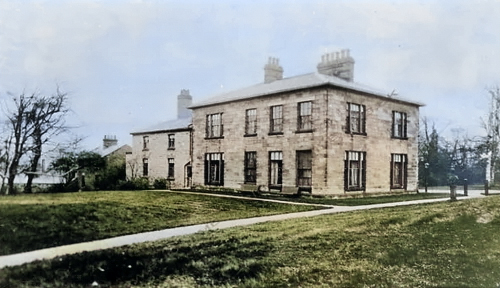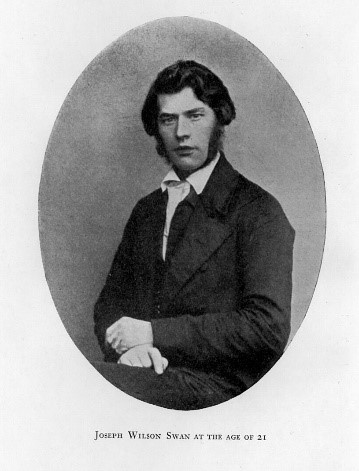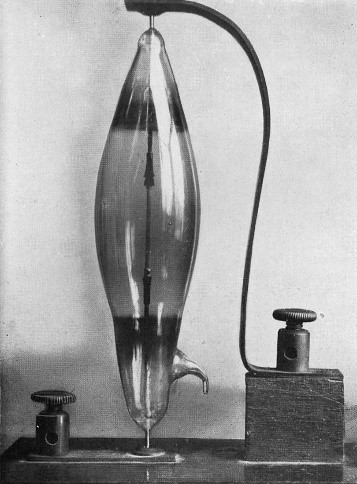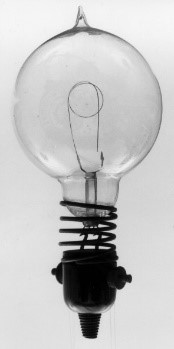Sir Joseph Wilson Swan - His Life and Inventions
|
Author: Peter A. Leyel, DFH, C. Eng., MIEE Note: The connection to the family Leijel is that the article's Sir Joseph Wilson Swan’s sister Emma Swan, (1837-1922) married Carl Fredrik Leijel, (1836-1876) December 14th 1872. Abstrakt Although achieving incandescence of a carbon filament as early as 1860, the first practical lamp had to await the invention of Herman Sprengler’s vacuum pump. In his lifetime, Joseph Swan was granted over 30 patents, covering not only photography, the incandescent electric lamp, but also improvements to the lead/acid storage battery, electric safety lamps, and creating filaments of nitro-cellulose, which led to the development of artificial silk. Swan was elected an FRS in 1894 and was knighted in 1904. 1. Early childhood
Young Swan enjoyed a happy childhood with his three brothers and four sisters in a large house with its grounds sloping down to the River Wear. His earliest childhood memories were of ship-building activities on the opposite side of the river, lime-kilns on the near side of the Wear and visiting a nearby glass factory. By age four, Swan was becoming aware of manufacturing processes. His uncle was a rope-maker and Swan often visited his factory, becoming acquainted with boilers, steam engines and a gas plant. In early boyhood, Swan remembered a family friend demonstrating an electrical machine with a Leyden jar, all of which aroused in him a keen, lasting interest in electricity. At age thirteen Swan left the boys’ school he and his older brother John attended, and in 1842 was apprenticed to Hudson and Osbaldiston, a firm of Sunderland druggists, with the intention of serving a six-year apprenticeship. However, in 1845, both principals of the firm having died, Swan joined his friend John Mawson in his chemist and druggist business in Newcastle. 2 . Early interests in Electric Lighting and Photography W.E. Staite, inventor of an improved regulated carbon arc lamp, visited Sunderland several times and Swan attended his lectures at the Athenæum. At one of these the principle of electric lighting by means of a piece of iridium-platinum wire was demonstrated. This demonstration caught Swan’s attention, and led him to consider production of light by incandescence of a thin conductor and, indeed, in his own words: “It was something of a seed sewn in my mind which germinated.”
Joseph Swan in 1849 During his apprenticeship in Sunderland, Swan spent much of his free time carrying out chemical and electrical experiments, mostly using apparatus of his own manufacture. He was much impressed by a large daguerreotype portrait of the owner of a shop in Bridge Street, displayed in the shop window. Daguerreotype photography, developed in the 1830s by Louis-Jacques-Mandé Daguerre of France, in collaboration with Joseph-Nicéphore Niepce, was the first successful form of photography. A great number of daguerreotype portraits were made in the mid-19th century, the technique being later supplanted by the wet collodion process. Another influence on young Swan came from a neighbourhood wood-turner who visited the chemist-shop seeking a pound of sulphate of copper and showed him a superb electrotype medallion depicting the head of Napoleon. The wood worker demonstrated how he had made this electrotype, and from that moment Swan became an ardent electro typist. John Mawson’s chemist business eventually metamorphosed into the well-known pharmacy of Mawson & Swan. Here Swan developed his growing interest in photography. His attention increasingly focused upon the problem of producing photographic prints that did not fade with time. He quickly became well known amongst Tyneside men interested in photography, and was soon able to begin manufacturing the collodion for which Mawson & Swan became famous. Photography was revolutionized in 1851 by introduction of the collodion process for making glass negatives. This new technique, invented by the English sculptor Frederick Scott Archer, was 20 times faster than all previous methods and was, moreover, free from patent restrictions. Glass plate negatives recorded detail in a way that rivalled the daguerreotype, and from them paper prints could be made. The process had one serious drawback: the photographer had to sensitise his plate almost immediately before exposure, and expose and process it whilst the coating was moist. Collodion is a solution of nitro-cellulose (gun-cotton) in alcohol and ether; when the solvents evaporate, a clear plastic-like film is formed. Since it is then impervious to water, the chemicals used for developing the exposed silver halides and removing the unexposed salts cannot penetrate to them. Despite the drawback that the photographer had to have a complete darkroom outfit with him at all times, the collodion process was swiftly universally adopted. It reigned supreme for more than 30 years and greatly increased the popularity of photography. Some of the most remarkable photographs of all time were produced by the wet-plate process. 3. Swan's Carbon Process of Photographic Printing In 1871, an English physician, Richard Leach Maddox, suggested use of gelatine in conjunction with bromide of silver as a substitute for collodion, thus introducing dry-plate photography. Attracted by the striking results obtained by this process, Swan started experimenting with the gelatino-bromide process, and quickly discovered the role heat played in it. This line of investigation led him to invent and, in 1879 to patent, bromide printing paper, in use for at least the next six decades of photographic printing — (patent GB2968/1879). 4. Early experiments with Electric Incandescent Carbon Lighting Towards the end of the 1870s, there was an awakening of interest in the possibilities of electric lighting. In 1862 the Dungeness lighthouse was equipped with an electric lamp, and in 1878 two articles appeared in The Times dealing with the relative merits of various ways of achieving electric lighting, at that time using carbon arc lamps. In 1878, Swan visited the Paris International Exhibition of Industry, where he saw various systems of electric arc lighting exhibited. In 1865, Herman Sprengel developed a mercury vapour vacuum pump capable of creating a far better vacuum than any previously obtained. This pump had been used by William Crookes (later Sir William) in 1875, during development of his radiometer. The publication of Crookes’ research spurred on Swan to resume his quest for a practical electric lamp, comprising an incandescent carbon filament in an evacuated glass envelope. Also, at this time Swan discovered a young Birkenhead bank clerk, Charles H. Stearn, who had experience creating near-perfect vacuums using the Sprengel pump, and was persuaded to experiment with carbon filaments supplied by Swan. Serious difficulties, at first encountered, were finally overcome by completing evacuation of the glass bulb when the carbon filament was at a high temperature created by a very heavy current passed through it. Only thus was the residual air in the envelope removed sufficiently to prevent blackening of the bulb.
1878 Swan Experimental Light After exhibiting his electric lamp, first at a December 1878 meeting of the Newcastle Chemical Society, and again at a January 1879 lecture delivered in Sunderland, Swan was invited to deliver a public lecture on his new method of electric lighting. Thus, it was that in February 1879, an audience of over seven hundred saw the lamp demonstrated at the Literary and Philosophical Society of Newcastle, followed in March by a lecture and demonstration before an audience of five hundred at the Town Hall, Gateshead. Improvements to this early model quickly followed, the most effective being use of a new material — cotton treated with sulphuric acid until it became plastic-like — instead of paper as used previously. This filament was .01 inch in diameter and had the appearance and other properties of metallic wire. Swan called his new material ‘parchmentized thread’ and patented it in November 1880 — (patent GB4933/1880). 5. First Edison Incandescent carbon light ‘Mr. Edison’, we are told, ‘has perfected an electric lamp of extraordinary simplicity with which he proposes a general illumination of the village on Menlo Park on New Year’s Eve. He has discovered that a steadier light is obtained by the incandescence of mere carbon paper than from any other known substance.’ Despite pressure from his young collaborator Charles Stearn, Swan did not patent his invention, whereas Edison applied for, and obtained, a British patent covering, in very general terms, the invention of an incandescent electric light featuring a carbon filament within an evacuated glass container — (patent GB4576/1879). In early 1880, Edison stopped using carbonized paper, substituting for his filaments carbonized strips of bamboo. 6. Manufacture of Swan Lamps The time was now ripe to consider commercial manufacture of Swan lamps. To this end a small company, the Swan Electric Lamp Company Ltd., was formed in Newcastle. Skilled glass-blowers were imported from Thuringia, Germany, and placed under the tutelage of Fred Topham, who had been employed by Swan’s early collaborator, Charles Stearn. After Swan’s home, the next private house in Great Britain to be lit by Swan lamps was that of his friend, Sir William Armstrong, in 1880. In early 1881, the Scottish home of Sir William Thomson, later Lord Kelvin, was illuminated throughout by Swan lamps, in addition to several Newcastle shops. 7. First Royal Naval warship electrically lit In early 1881, Captain Jackie Fisher (later Lord Fisher, Admiral of the Fleet) dined with the President of the Royal Society, Sir William Spottiswoode, and was much impressed by the lighting of the dining room, accomplished by Swan electric lights. Captain Fisher, at the time commanding the four-gun twin screw turret battleship H.M.S. Inflexible, immediately wrote to Swan, asking whether such lights could be introduced into the Royal Navy for his ship. Edmund, at the time working with the Swan Electric Lamp Co., was asked to go to Portsmouth to demonstrate the suitability of the lamps. To quote from his book: ‘At Portsmouth I was met by Captain Fisher, who took me over the Inflexible … he had arranged a demonstration in a shed in the dockyard, which had been darkened for the purpose. … At last, we got our lamps to glow satisfactorily, and at that moment the Admiral was announced. … The Admiral appeared, resplendent in gold lace, and accompanied by such a bevy of ladies that I was strongly reminded of the character in H.M.S. Pinafore “with his sisters, and his cousins and his aunts”. The Admiral immediately asked if I had seen the Inflexible. I replied that I had. “Have you seen the powder magazine?” “Yes! I have been to it.” “What would happen to one of these little glass bubbles in the event of a broadside?” I did not think it would affect them. “How do you know? You’ve never been in a ship during a broadside!” I saw Captain Fisher’s eye fixed on me, and a sailor was dispatched for some gun-cotton. Evidently everything had been already prepared, for he quickly returned with a small tea-tray about two feet long, upon which was a layer of gun-cotton powdered over with black gunpowder. The Admiral asked if I was prepared to break one of the lamps over the tray. I replied that I could do so quite safely, for the glowing lamp would be cooled down by the time it fell amongst the gun-cotton. I took a cold chisel, smashed a lamp and let it fall. The company saw the light extinguished and a few pieces of glass fall on the tray. There was no flash and the gunpowder and gun-cotton remained as before. There was a short pause, while the Admiral gazed on the tray. Then he turned and said to Captain Fisher, “We’ll have this light in the Inflexible.”’ This confidence was obviously justified as, some months later, H.M.S. Inflexible under the command of Captain Jackie Fisher played a key part in the bombardment of Alexandria in July, 1882. Although the ship was extensively damaged by Egyptian gunfire, no explosion or fire occurred due to a shattered light bulb. 8. London Public Buildings lit, and first Swan factory in Paris In May 1882 the company was renamed Swan’s United Electric Light Company Ltd., with an increased capital of a million pounds, and in 1883 installed the lighting at London’s Law Courts. The light bulb was now big business. Meanwhile, a factory similar to that in Newcastle was opened in Paris, to manufacture lamps for the French market, following a very successful 1881 exhibition of Swan’s incandescent lighting at the Palais de l’Industrie in the Champs Elysées. Following the Paris exhibition Joseph Swan received the Légion d'honneur in recognition of his invention. A young mechanical engineer, James Swinburne, was sent from England to set up the Paris factory, and by the end of 1881 Swan lamps manufactured in Paris were being supplied to French customers. As had happened previously in Newcastle, skilled glass-blowers for the French factory had to be recruited from Thuringia, Germany. 9. Swan’s improvement of the Lead/Acid storage cell 10. Formation of the Edison Swan United Electric Light Co.Ltd. In early 1883, Swan removed his family from Gateshead, County Durham, to a new home in Bromley, Kent, enabling him to be closer to the Company in London. Buildings were soon erected close to his new house, where Swan could continue his experimental work. The main house and buildings were, of course, illuminated by Swan incandescent lamps, the electrical supply coming from a large battery of secondary cells, which could be recharged by a gas-engine dynamo of Swan’s design. One of his first tasks, undertaken at Bromley, was to improve the existing carbon ‘parchmentised’ cotton thread then being used for filaments of the Swan lamps. On the last day of 1883 Swan patented a new method of making filaments by squirting nitro-cellulose, under pressure, through a small orifice into a coagulating fluid of methylated spirits — (patent GB5978/1883). The resulting thread was washed and the nitric acid removed with ammonium sulphide — the thread was then cut, shaped and carbonized for use as filaments. This method of manufacture proved extremely economical and was quickly adopted by the Edison & Swan factory.
Swan Lampa of 1884 11. Artificial Silk 12. Honours and Recognition In December 1904, the Royal Society awarded Swan the Hughes Medal for his invention of the incandescent electric lamp, and his other inventions, and improvements in practical applications of electricity. In his acceptance speech, Swan spoke of inventors: “An inventor is an opportunist, one who takes occasion by the hand; who, having seen where some want exists, successfully applies the right means to attain the desired end. The means may be largely, or even wholly, something already known or there may be a certain originality or discovery in the means employed. But in every case the inventor uses the work of others. If I may use a metaphor, I should liken him to the man who essays the conquest of some virgin alp. At the outset he uses the beaten track and, as he progresses in the ascent, he uses the steps made by those who have preceded him, whenever they lead in the right direction, and it is only after the last footprints have died out that he takes ice-axe in hand and cuts the remaining steps — few or many — that lift him to the crowning height which is his goal.” Joseph Swan was knighted in 1904, and in 1906 the Prince of Wales, as President of the Society of Arts, presented him with the Albert Medal for his inventions in connection with the electric lamp and photography. He retired from hectic London life in 1908, and moved the family to a house in Warlingham, a village in Surrey. Here he passed away peacefully in the early hours of 27th May 1914. Thus ended the life of a man whose inventions have made a considerable contribution to the comfort and way of life of our modern world. At the time of his birth houses were lit by the flickering light of candles or fires, photography was unknown and the automobile had not yet been thought of. At the time of his death, many private homes and most public buildings enjoyed the benefit of electric lighting, photography was becoming available to the masses, and automobiles used re-chargeable storage batteries based upon Joseph Swan’s designs.
The author of this paper would like to add that he had a special interest in researching the life of Joseph Wilson Swan — the youngest sister of Sir Joseph, Emma Swan, born 1837, was the author’s great-Grandmother.
Sources: Kenneth R Swan, K.C., Sir Joseph Swan and the Invention of the Incandescent Electric Lamp, published for the British Council by Longmans, Green and Co, London 1946 G.Wharton Simpson, M.A, On the Production of Photographs in Pigments containing Historical Notes on Carbon Printing and Practical Details of Swan’s Patent Carbon Process, published by Thomas Piper, London 1867 Encyclopaedia Britannica from Encyclopaedia Britannica 2004 Ultimate Reference Suite DVD The author would also like to thank the British Library for providing him with a list of the patents granted to Joseph Wilson Swan between 1877 and 1887.
Some additional (unpublished) notes: George Short, shipbuilder, lived there from 1850. It was the birthplace of Sir Joseph Wilson Swann, inventor of the incandescent light bulb. The stairs and many other fittings were removed to Unthank Hall in Northumberland. During the 19th century the house was bought by Sunderland ropemaker Christopher Webster married to Mary Laing from another prominent ropebuilding family and they lived at Pallion Hall until their deaths in 1894 and 1899 respectively. Writing in 1892 the local historian Taylor Potts recorded that Christopher Webster 'laid out the whole river frontage of his Pallion estate - extending from the corner of the West Quay to his eastern boundary - for wood shipyards, but they were not fully occupied until years later.' The 1870 OS map shows the house in wooded grounds on the west side, glasshouses and a kitchen garden near the south boundary as well as drives and walks. On the east side of the house were a stable block and lodge. Source: P. Meadows and E. Waterson, 1993, Lost Houses of County Durham, p 45
|

 Pallion Hall, Sunderland
Pallion Hall, Sunderland

